|
Food and drink biodiversity:
Edible legumes
Legumes are plants that fall in the family
Fabaceae, which formally was more
commonly referred to as the Leguminosae. They are easily identified by their
distinctive pods. Pulses are annual legumes that are cultivated for their
seed. All the commercially grown species listed below are pulses, while the list
of indigenous legumes eaten in southern Africa is of wild species that are
little or not cultivated and some of these are perennials.
Domestication of pulses involved selection for the
following traits (Zohary & Hopf 1994).
-
Retainment of seed in the pod. Many wild
legumes have pods that burst open when mature, releasing their seeds.
Domestication has involved selecting for pods that do not burst open or
split open slowly. This enables them to be harvested without loss of seeds.
-
Larger seeds. Domesticated pulses generally
have larger seeds, with the obvious advantage of having a higher food
content.
-
Thinner seed coats. A thick seed coat protects
the seed and also delays germination. By selecting for thinner seed coats,
one is reducing germination delays and also the seed is more permeable to
water.
-
Stiffer stems. Wild forms were often climbers
or small, delicate plants. There was selection for plants that were
free-standing, with stiffer stems that could be cultivated in open fields.
-
Reduced toxins. Wild plants often had chemical
defences (toxins and antimetabolites) that made the seeds unpalatable to
herbivores. Under the process of domestication there was selection for
plants that lacked toxins or had them in reduced quantities.
The domestication of pulses went hand-in-hand with the
domestication of grains. Whereas grains are rich in carbohydrates, pulses are
rich in protein. Eaten in combination, one has a more balanced diet. Pulses
serve as an important meat substitute.
The main reason that seeds of legumes contain high levels
of protein is that legumes have a symbiotic association with root bacteria of
the genus Rhizobium. These bacteria are able to convert atmospheric
nitrogen into nitrogenous chemical compounds that can be used by the plant to
synthesize amino acids and from these proteins. From a purely agricultural
point of view there was a hand-in-hand relationship between pulses and grains:
whereas grain crops used up nitrogen in the soil, legume crops added nitrogen to
the soil. Rotation between these two crops therefore was important in
maintaining soil fertility.
Each agricultural civilization therefore developed not
only its own staple cereals but also its own legume crops:
Commercial species (pulses)
Arachis hypogaea
(Peanut, Groundnut)
Family: Fabaceae
Groundnuts were domesticated by indigenous people in
the region of Argentina and Bolivia over 4000 years ago. The seedpods
mature underground, hence the name groundnuts. Peanuts are nutritious in
that they contain 45-50% oil and 25-30% protein as well as having certain
vitamins. However, peanuts infested with fungal aflatoxin and eaten in
large quantities can cause liver cancer in people.
|
|
Cajanus cajan (Pigeon pea) Family: Fabaceae
Evidence suggests that Pigeon pea originated in India and
from there was introduced to East Africa around 4000 years ago. It is grown in semi-arid and subtropical areas of
the world, including Asia, Africa and South America. In Africa the main
countries growing Pigeon pea are Kenya, Malawi, Uganda, Tanzania and Nigeria,
but it is also grown in southern Africa in warm regions. It is grown mainly
as a subsistence crop: seeds are eaten and young pods are eaten as a
vegetable. |
|
|
Cicer arietinum (Chickpea)
Family: Fabaceae
Originates from south-eastern Turkey. Wild chickpeas were being harvested
by people 9500 years ago, and by 8500 years ago there is evidence that chickpeas
were being cultivated. The seeds have high levels of protein and are eaten whole
or ground into flour that has a wide variety of uses. Hummus dip is
made from ground up chickpeas and sesame oil. |
|
|
Glycine max
(Soybean)
Family: Fabaceae
Domesticated in northeastern China from the wild
Glycine soja, the earliest evidence of cultivation dating to 3000 years
ago. |
|
|
Lens culinaris
(Lentil)
Family: Fabaceae
Originates from the Near East and central Asia.
People were harvesting wild lentils by 11200 years ago and by 8800 years
ago lentils were being cultivated. |
|
|
Phaseolus lunatus
(Lima bean)
Family: Fabaceae
Lima Beans originate from Central and South America where
they were domesticated at least 8500 years ago. |
|
|
Phaseolus vulgaris (Green beans, Large white beans, Flageolet, Black bean,
Borlotto bean, Red kidney bean, Cannellino bean, Sugar bean, Haricot bean)
Family: Fabaceae
Originate from Central and South America. The earliest
archaeological evidence of domesticated bean seeds is from 7500 years ago
at a site in mountainous northern Peru. Phaseolus vulgaris also
includes Large white beans, Flageolet, Black bean, Borlotto bean, Red
kidney bean and Cannellino bean. |
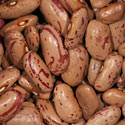
Sugar beans
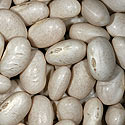
Haricot beans
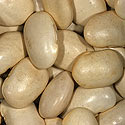
Kidney beans |
|
Pisum sativum
(Pea)
Family: Fabaceae
Originates from the Near East, was being eaten by
people at least 9500 years ago, and by 8500 years ago there is evidence of
pea cultivation. |
|
|
Vicia faba
(Broad Bean)
Family: Fabaceae
Bean seeds and very young pods
are eaten as a vegetable. Seeds have a high protein content of about
20-25%. Broad Bean was probably domesticated in the eastern Mediterranean
region in the late Neolithic (about 6800- 4500 BC) but precise
evidence is lacking and in addition we have no idea of the wild plant
species from which it was derived. |
|
Vigna subterranea
(Jugo bean, Bambara groundnut, African groundnut) Family: Fabaceae Jugo bean is native to
West Africa but is now grown widely as a crop in the tropical regions of
Africa. It has the advantage of being able to be reasonably productive even
under extreme conditions such as drought and poor soil. It is similar to
Arachis hypogea
(Groundnuts) in that the flowers curl down into the ground so that the pods end up developing and maturing underground.
Otherwise, the two plants are quite different in appearance. Each pod has only
one or two seeds. Seeds are eaten raw or cooked, or are ground into a flour. |
|
Vigna radiata
(Mung bean)
Family: Fabaceae Mung beans originate from India and India remains a
leading producer of this legume. Most mung beans are olive green in colour
but they can also be yellow, brown, or mottled black. They are an excellent
source of folic acid and a good source of magnesium, phosphorus and thiamin.
Mung beans are an important food in rural areas of southern Africa, where
the dry bean seeds are used or the beans themselves are eaten as a
vegetable. |
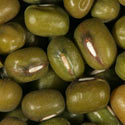 |
Vigna unguiculata (Cowpea)
Family: Fabaceae
Native to Africa, including southern Africa. It is an
important commercial crop in Africa and is also grown as a subsistence crop.
Seeds are stored dry and used in various dishes. The leaves and young pods
are used fresh or dry as a green vegetable. |
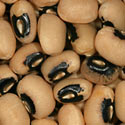 |
Indigenous species utilised in southern Africa
Information mainly from van Wyk and Gericke (2000)
Bauhinia petersiana
(Wild coffee bean) Family: Fabaceae Seeds are roasted and
eaten as nuts. Roasted seeds are also ground up and used as a coffee
substitute.
|
|
Canavalia ensifolia (Jack bean) Family: Fabaceae
Jack bean is a creeper that is cultivated in some rural
regions of southern Africa. In order to make the seeds palatable, they need
to be well-cooked and the seed coat removed. Seeds are also ground up and
used as a coffee substitute. |
|
Guibourtia coleosperma (Copalwood) Family: Fabaceae
A tree that occurs in the Kalahari sands of northern
Namibia and northern Botswana. Each seed is covered in a bright red
aril. The !Khu Bushmen of NE Namibia remove the seed coat and eat the seed
raw, roasted or pounded up. The oily aril is also eaten, especially under
famine conditions. They use other parts of the plant for medicinal purposes.
|
|
Schotia spp. (boer-beans) Family: Fabaceae
Seeds are edible. In Schotia afra they can
evidently be eaten raw when green. Mature seeds need to be first cooked or
roasted. |
|
Tylosema esculentum (Marama
bean) Family: Fabaceae This species grows in the Kalahari and
the pod contains two to six
large seeds, measuring about 2 cm in diameter and each weighing about 3 grams.
Within the 2 mm thick seed coat is a tasty white nut. The potential of this
species as a crop plants in arid regions is such that it is being grown in
Texas, Australia and Israel, with a view to developing superior plants through
selective breeding. Nuts are first roasted then eaten. Roasted nuts are also
ground up and used as a coffee substitute or for porridge. The closely
related Tylosema fassoglense also has edible nuts. |
|
Vigna vexillata (Wild sweetpea) Family: Fabaceae
This species is native to southern Africa and is
evidently cultivated on a small scale in some areas for eating of the beans
and seeds. |
|
Publications
-
Anon. 2002. Encyclopedia of Foods. A Guide
to Healthy Nutrition. Academic Press, San Diego, California.
-
Sauer, J.D. 1993. Historical geography of
crop plants - a select roster. CRC Press, Boca Raton, Florida.
-
van Wyk, B.-E. & Gericke, N. 2000. People's
Plants. A Guide to Useful Plants of Southern Africa. Briza Publications,
Pretoria.
|
